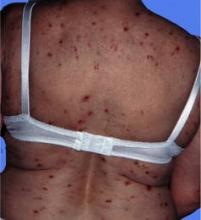In patients thought to have delusional infestation, neither skin biopsy nor microscopic examination of patient-provided "specimens" is likely to change the clinical diagnosis, according to a report published online May 16 in the Archives of Dermatology.
Performing such analyses might yield other benefits, such as assuring the patient that he or she is being taken seriously, but clinicians should understand that these procedures do not yield any important objective evidence, wrote Sara A. Hylwa, a visiting medical professional for research, and her associates at the Mayo Clinic in Rochester, Minn.
Delusional infestation is characterized by patients’ fixed and false belief that their skin is infested by pathogens. These can be animate, such as "bugs," worms, fungi, or bacteria, or they can be inanimate, such as "fibers," wood chips, or small tubes. Patients with this disorder frequently bring in specimens they have collected as proof of the infestation.
Ms. Hylwa and her colleagues performed what they said was "the first study that has addressed the histologic analysis of skin biopsy specimens and patient-provided specimens from a relatively large number of patients presenting with delusional infestation." They examined the records of all 108 patients treated at the Mayo Clinic for the disorder from 2001 to 2007.
Eighty of these patients underwent skin biopsy, 80 brought in specimens, and 52 had both.
Three-fourths of the patients were women, and mean symptom duration was 2 years (range, 2 weeks to 23 years). The patients reported that they were infested with bugs (79%), worms (20%), eggs of unspecified species (3%), fibers (22%), "specks" (7%), "triangles" (2%), granulous material (2%), and/or one each of the following: thorns, splinters, rotting wood fungus, Styrofoam, glass, car oil, nails, and gel.
None of the 121 biopsies (117 skin, 2 tongue, 1 hair, and 1 muscle) demonstrated evidence of infestation, nor did any patient-provided specimen. And among the dozens of other tests performed, such as stool ova and parasite analysis and skin cultures, none showed any evidence of infestation.
Of the 80 patient-provided specimens, all but two contained only insects that do not infest humans and cutaneous debris such as skin flakes, scabs, crusts, and hair. One stool sample contained an earthworm.
Only one patient-provided specimen proved to contain a true parasite (a pubic louse); however, that patient did not have lice, and pubic lice could not account for the patient’s symptoms, which chiefly involved the fingernails. Another patient provided a tick, but a tick could not have produced the skin eruption seen in that patient, the investigators said (Arch. Dermatol. 2011 May 16 [doi:10.1001/archdermatol.2011.114]).
Interestingly, 61% of patients showed some form of dermatitis on skin biopsy, and almost half had excoriations, ulcerations, or erosions. This high prevalence of dermatitis "raises the possibility that atypical sensations in the skin may be precipitated by a true pathologic condition (dermatitis) and interpreted mistakenly by the patient as insects crawling from the skin," the researchers said.
Similarly, cutaneous crusting and debris from scratches and excoriations might be misinterpreted as pathogens that emerged from the skin.
On the other hand, the dermatitis may have been a result, rather than a cause, of the patient’s belief in infestation. Rubbing and picking at the supposedly infested skin could have resulted in contact dermatitis, and many patients reported that they had applied caustic substances to their skin to "get rid of" the infestation, which could have lead to an irritant or allergic contact dermatitis, Ms. Hylwa and her associates wrote.
The findings raise questions about the value of performing skin biopsies and other procedures in these patients.
"Some have proposed that an alliance with a patient is a justification for a skin biopsy, but is it? What is the outcome following a biopsy? Did it improve the outcome of the interaction with the patient? Were patients more likely to be compliant with therapy following a biopsy?" the researchers asked.
No relevant conflicts of interest were reported.


